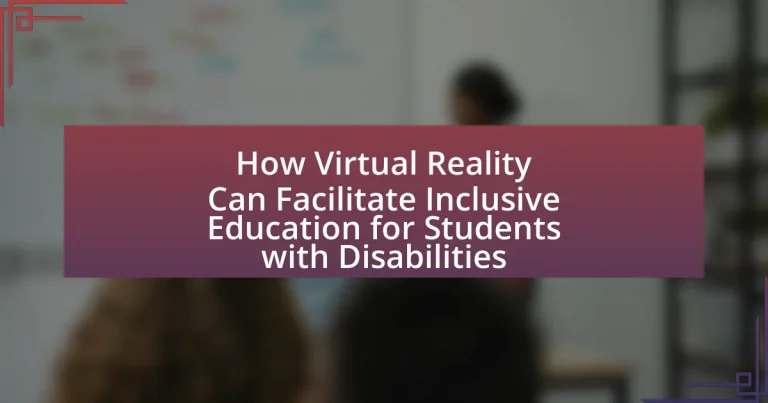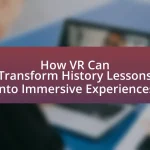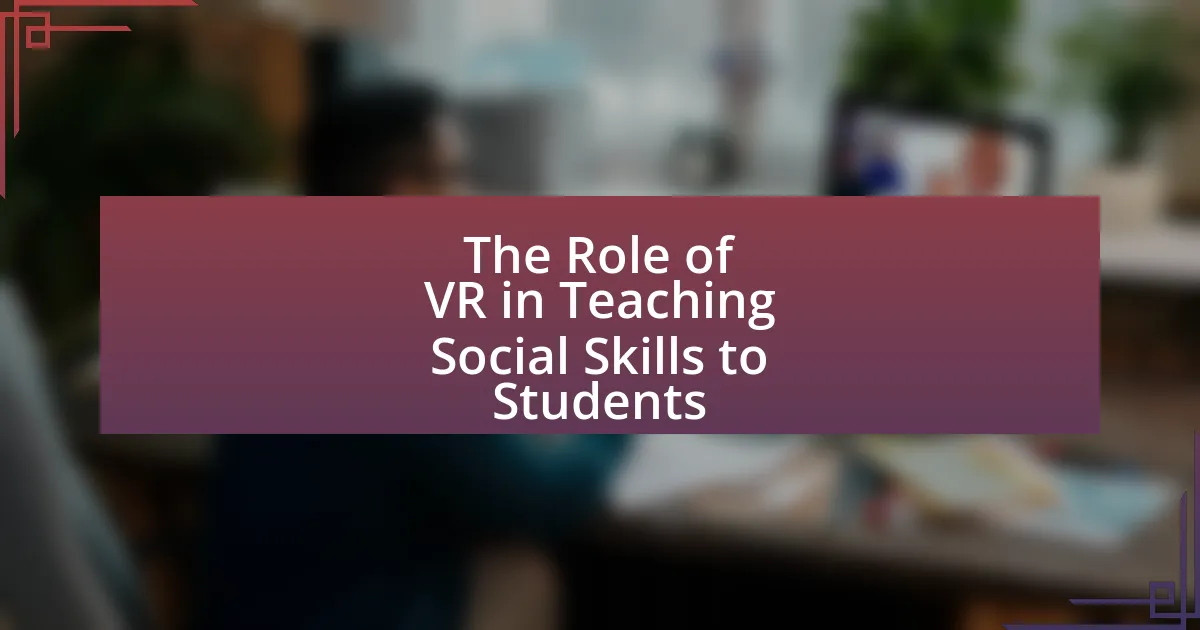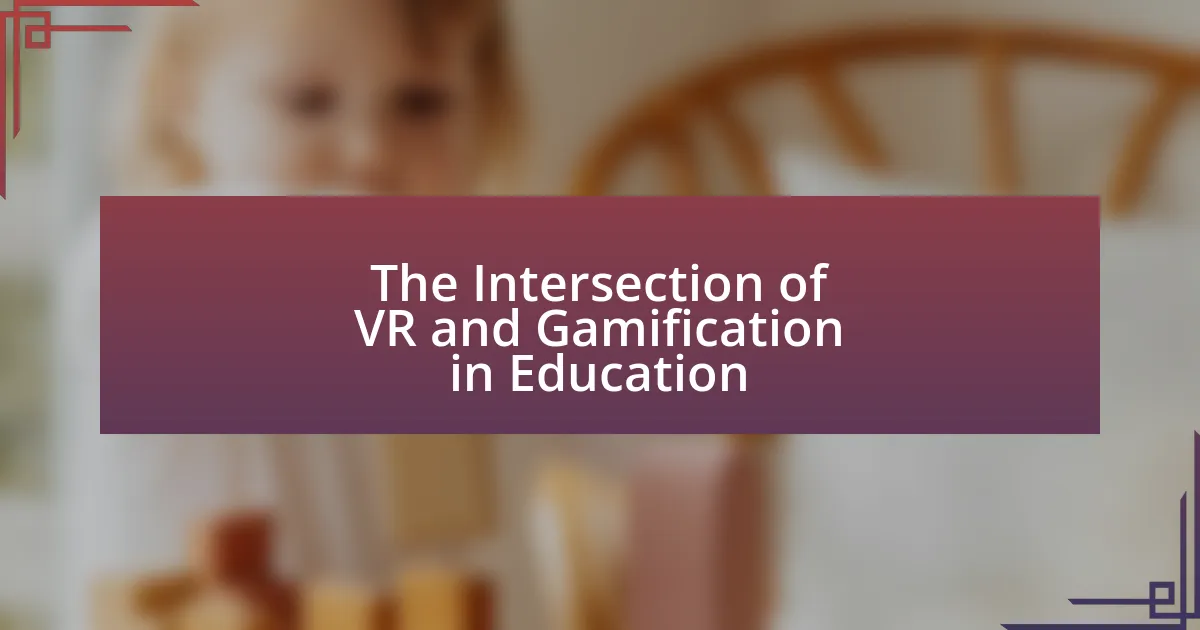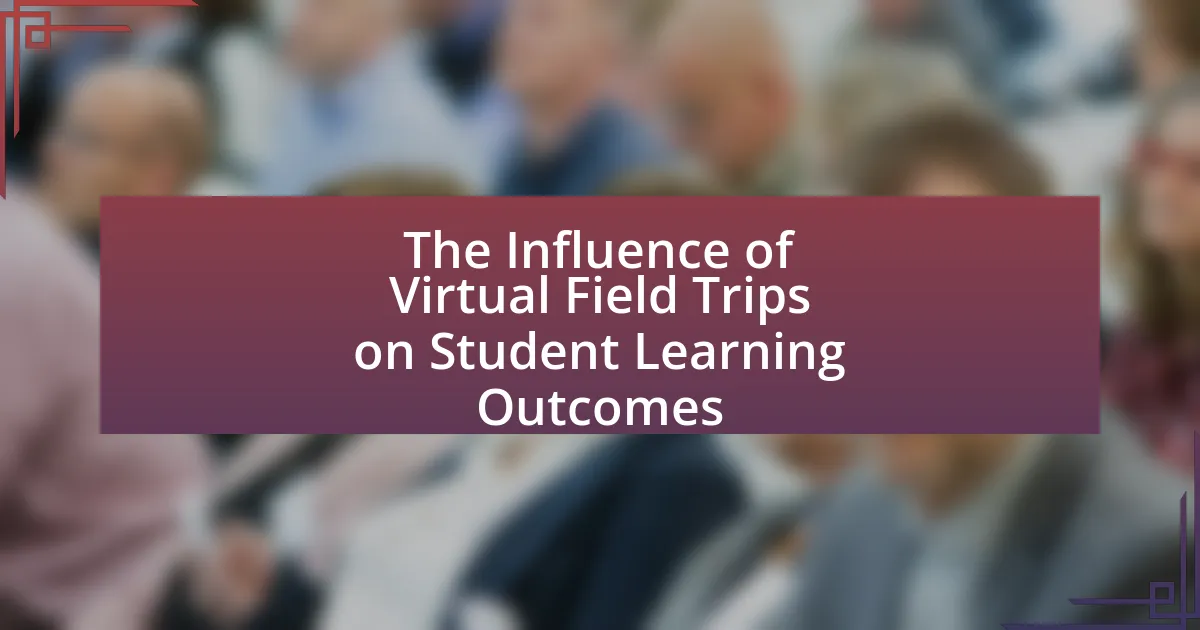The article focuses on how Virtual Reality (VR) can enhance inclusive education for students with disabilities by providing tailored, immersive learning experiences. It outlines key features of VR, such as personalized learning environments and interactivity, which support diverse learning needs and improve engagement. The article discusses the importance of inclusive education, the challenges faced by students with disabilities in traditional settings, and how VR can address these challenges by facilitating social skills development and reducing physical barriers. Additionally, it highlights the implications for educators, best practices for integrating VR into classrooms, and future developments in VR technology aimed at promoting inclusivity in education.
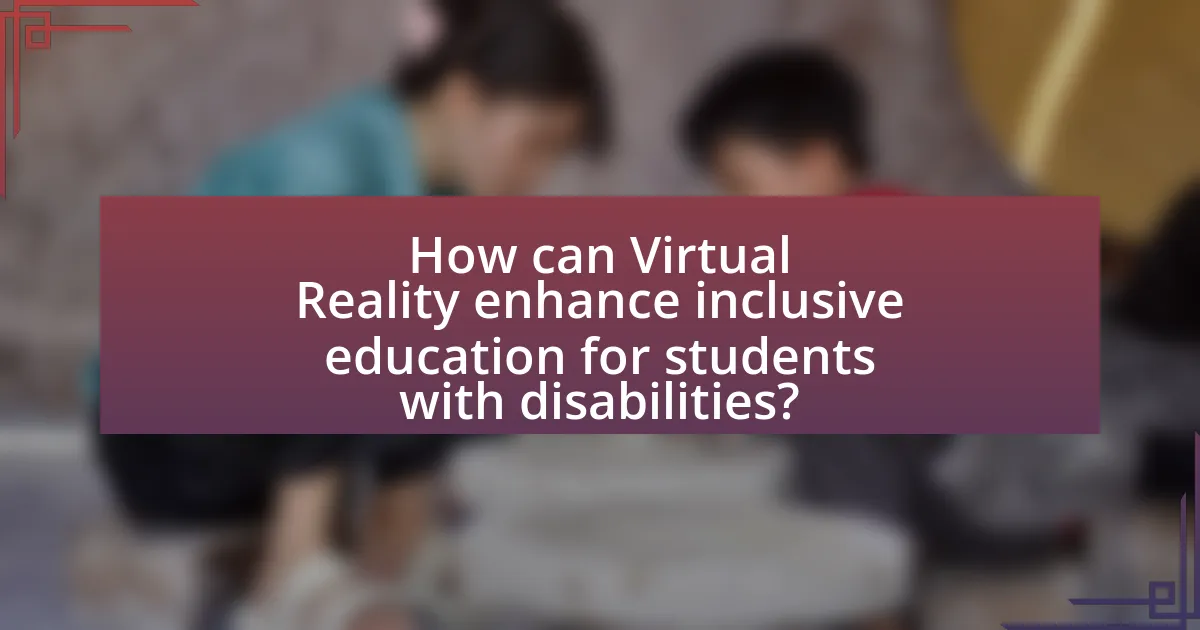
How can Virtual Reality enhance inclusive education for students with disabilities?
Virtual Reality (VR) can enhance inclusive education for students with disabilities by providing immersive and interactive learning experiences tailored to individual needs. VR technology allows students to engage in simulations that accommodate various learning styles and physical limitations, fostering a more inclusive environment. For instance, studies have shown that VR can improve social skills and communication for students with autism by creating safe spaces for practice and interaction. Additionally, VR can facilitate access to environments and experiences that may be physically challenging for students with mobility impairments, thus promoting equal learning opportunities.
What are the key features of Virtual Reality that support inclusive education?
The key features of Virtual Reality (VR) that support inclusive education include immersive learning experiences, personalized learning environments, and enhanced engagement. Immersive learning experiences allow students to interact with content in a three-dimensional space, which can be particularly beneficial for students with disabilities who may struggle with traditional learning methods. Personalized learning environments enable educators to tailor experiences to meet individual needs, accommodating various learning styles and abilities. Enhanced engagement through gamification and interactive scenarios keeps students motivated and focused, leading to improved learning outcomes. Research indicates that VR can significantly enhance understanding and retention of information, making it a powerful tool for inclusive education.
How does immersive technology improve learning experiences for students with disabilities?
Immersive technology significantly enhances learning experiences for students with disabilities by providing tailored, interactive environments that cater to diverse learning needs. For instance, virtual reality (VR) allows students to engage in simulations that can accommodate various sensory and cognitive challenges, enabling them to practice real-world skills in a safe and controlled setting. Research conducted by the University of Southern California found that VR can improve engagement and retention rates among students with disabilities by up to 30%, demonstrating its effectiveness in fostering an inclusive educational experience.
What role does interactivity play in Virtual Reality for education?
Interactivity in Virtual Reality (VR) plays a crucial role in enhancing educational experiences by allowing students to engage actively with the learning material. This active engagement fosters deeper understanding and retention of information, as students can manipulate objects, explore environments, and participate in simulations that reflect real-world scenarios. Research indicates that interactive VR environments can improve learning outcomes, particularly for students with disabilities, by providing tailored experiences that accommodate diverse learning needs. For instance, a study published in the journal “Computers & Education” by Mikropoulos and Natsis (2011) found that interactive VR applications significantly increased motivation and engagement among learners, leading to improved academic performance. Thus, interactivity in VR not only enriches the educational experience but also supports inclusive practices by catering to various learning styles and abilities.
Why is inclusive education important for students with disabilities?
Inclusive education is important for students with disabilities because it promotes equal access to learning opportunities and fosters social integration. Research indicates that inclusive settings enhance academic performance and social skills among students with disabilities, as they learn alongside their peers in a supportive environment. A study by the National Center for Learning Disabilities found that students with disabilities in inclusive classrooms demonstrate improved engagement and self-esteem, which are critical for their overall development.
What are the benefits of inclusive education for students with disabilities?
Inclusive education for students with disabilities promotes social integration, enhances academic performance, and fosters a sense of belonging. Research indicates that students with disabilities in inclusive settings demonstrate improved social skills and peer relationships, which are crucial for their emotional and social development. A study published in the Journal of Special Education found that inclusive education can lead to higher academic achievement, as students benefit from diverse teaching strategies and collaborative learning environments. Furthermore, inclusive education prepares all students for a diverse society, equipping them with the skills to interact with individuals of varying abilities.
How does inclusive education impact social skills and peer relationships?
Inclusive education enhances social skills and peer relationships by fostering an environment where diverse learners interact and collaborate. This interaction promotes empathy, communication, and teamwork among students, as they learn to appreciate different perspectives and abilities. Research indicates that inclusive settings lead to improved social competence and friendships among students with and without disabilities, as evidenced by a study published in the “Journal of Special Education” by McLeskey and Waldron, which found that inclusive classrooms significantly increased positive peer interactions.
What challenges do students with disabilities face in traditional educational settings?
Students with disabilities face significant challenges in traditional educational settings, including physical accessibility issues, inadequate support services, and social stigma. Physical accessibility barriers, such as stairs and narrow hallways, hinder mobility for students with physical disabilities. Inadequate support services, including insufficient individualized education plans (IEPs) and lack of trained staff, limit the ability of these students to receive tailored educational experiences. Additionally, social stigma and bullying can lead to isolation and decreased participation in classroom activities, negatively impacting their academic performance and emotional well-being. According to the National Center for Learning Disabilities, approximately 1 in 5 students in the U.S. has a learning disability, highlighting the need for more inclusive practices in education.
How do physical barriers affect learning for students with disabilities?
Physical barriers significantly hinder learning for students with disabilities by limiting their access to educational resources and environments. These barriers can include inaccessible classrooms, lack of adaptive technology, and physical obstacles that prevent mobility. For instance, a study by the National Center for Learning Disabilities found that 1 in 5 students with disabilities reported that physical barriers in schools negatively impacted their ability to participate in learning activities. This limitation can lead to decreased engagement, lower academic performance, and increased feelings of isolation among these students.
What psychological challenges do students with disabilities encounter in schools?
Students with disabilities encounter several psychological challenges in schools, including anxiety, low self-esteem, and social isolation. These challenges often stem from difficulties in communication, academic performance, and social interactions, which can lead to feelings of inadequacy and frustration. Research indicates that students with disabilities are at a higher risk for developing anxiety disorders, with studies showing that approximately 40% of students with disabilities report experiencing significant anxiety related to school environments. Additionally, the stigma associated with disabilities can exacerbate feelings of isolation, making it harder for these students to form peer relationships and engage in social activities.
How does Virtual Reality address these challenges?
Virtual Reality (VR) addresses challenges in inclusive education for students with disabilities by providing immersive and interactive learning experiences tailored to individual needs. VR enables personalized learning environments where students can engage with content at their own pace, accommodating various learning styles and abilities. For instance, studies have shown that VR can enhance social skills and communication for students with autism by simulating real-life social interactions in a controlled setting. Additionally, VR can reduce physical barriers by allowing students with mobility impairments to participate in virtual field trips or simulations that would be inaccessible in the real world. This adaptability and accessibility make VR a powerful tool in promoting inclusivity in education.
What specific VR applications are designed for students with disabilities?
Specific VR applications designed for students with disabilities include “VR Therapy,” which provides immersive environments for therapeutic interventions, and “ClassVR,” which offers educational content tailored for diverse learning needs. “Engage” is another application that facilitates social interaction and collaboration among students with disabilities in virtual classrooms. Research indicates that these applications enhance engagement and learning outcomes for students with disabilities by providing tailored experiences that accommodate various needs.
How can VR simulations create a safe learning environment for students with disabilities?
VR simulations can create a safe learning environment for students with disabilities by providing immersive, controlled experiences that reduce anxiety and enhance engagement. These simulations allow students to practice skills and navigate social situations in a risk-free setting, which can be particularly beneficial for those with social anxiety or sensory sensitivities. Research indicates that VR can improve learning outcomes by offering personalized pacing and tailored scenarios that accommodate individual needs, thereby fostering confidence and independence. For instance, a study published in the journal “Computers & Education” by Mikropoulos and Natsis found that VR environments significantly enhance the learning experience for students with disabilities by allowing them to interact with content in a way that traditional methods cannot.
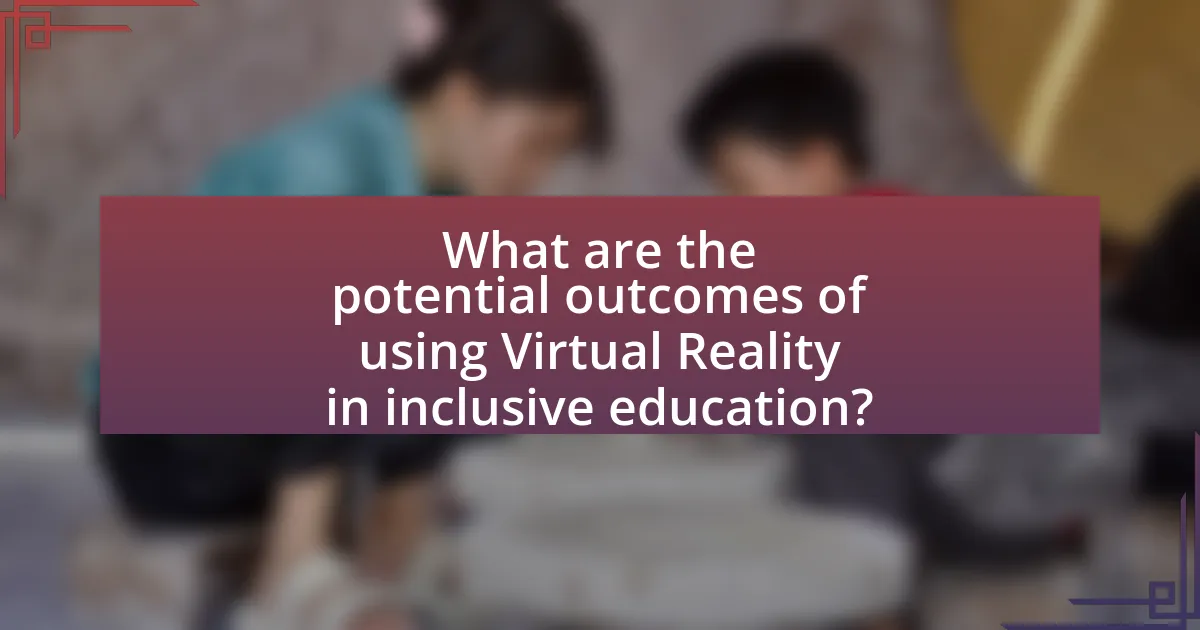
What are the potential outcomes of using Virtual Reality in inclusive education?
The potential outcomes of using Virtual Reality (VR) in inclusive education include enhanced engagement, improved learning retention, and increased accessibility for students with disabilities. VR creates immersive learning environments that cater to diverse learning styles, allowing students to interact with educational content in a more meaningful way. Research indicates that students with disabilities often show higher levels of motivation and participation when using VR, as it can simulate real-world experiences that may be challenging to access otherwise. For instance, a study by Mikropoulos and Natsis (2011) found that VR can significantly improve spatial awareness and social skills in students with autism, demonstrating its effectiveness in fostering inclusive educational practices.
How does Virtual Reality improve engagement and motivation among students with disabilities?
Virtual Reality (VR) improves engagement and motivation among students with disabilities by providing immersive, interactive experiences that cater to diverse learning needs. VR allows students to participate in simulations and scenarios that enhance their understanding and retention of information, making learning more enjoyable and effective. For instance, a study published in the journal “Computers & Education” by Mikropoulos and Natsis (2011) found that VR environments significantly increased student engagement and motivation, particularly for those with learning disabilities, by offering personalized learning experiences that traditional methods often lack. This tailored approach helps students with disabilities overcome barriers to learning, fostering a sense of achievement and encouraging active participation in their education.
What evidence supports the effectiveness of VR in enhancing learning outcomes?
Evidence supports the effectiveness of virtual reality (VR) in enhancing learning outcomes through various studies demonstrating improved engagement, retention, and skill acquisition. For instance, a study by Mikropoulos and Natsis (2011) published in the journal Computers & Education found that students using VR for learning complex concepts in science showed a 30% increase in retention rates compared to traditional methods. Additionally, research by Merchant et al. (2014) in the Journal of Educational Technology & Society indicated that VR environments significantly enhance motivation and engagement, leading to better academic performance. These findings collectively illustrate that VR can create immersive learning experiences that cater to diverse learning needs, particularly beneficial for students with disabilities.
How can VR facilitate personalized learning experiences for students with disabilities?
Virtual Reality (VR) can facilitate personalized learning experiences for students with disabilities by providing immersive environments tailored to individual needs. VR technology allows for customized simulations that cater to various learning styles and abilities, enabling students to engage with content in a way that suits them best. For instance, students with autism can benefit from social skills training in controlled virtual settings, which has been shown to improve their interaction skills (Parsons et al., 2017, “The Role of Virtual Reality in the Development of Social Skills in Children with Autism,” Journal of Autism and Developmental Disorders). Additionally, VR can offer adaptive learning experiences, such as adjusting the difficulty level of tasks in real-time based on student performance, thereby promoting a more effective learning pace. This adaptability is crucial for students with disabilities, as it allows them to progress at their own speed while receiving immediate feedback and support.
What are the implications for educators using Virtual Reality in the classroom?
The implications for educators using Virtual Reality (VR) in the classroom include enhanced engagement, personalized learning experiences, and improved accessibility for students with disabilities. VR technology allows educators to create immersive environments that cater to diverse learning styles, thereby increasing student motivation and participation. Research indicates that VR can significantly improve learning outcomes; for instance, a study published in the Journal of Educational Technology & Society found that students using VR demonstrated a 30% increase in retention rates compared to traditional teaching methods. Additionally, VR can provide simulations that help students with disabilities navigate social situations and develop essential skills, making education more inclusive.
What training do educators need to effectively implement VR in inclusive education?
Educators need specialized training in both virtual reality technology and inclusive teaching strategies to effectively implement VR in inclusive education. This training should encompass understanding the functionalities of VR tools, designing accessible content, and applying pedagogical approaches that cater to diverse learning needs. Research indicates that educators who receive targeted professional development in these areas are more successful in integrating VR into their classrooms, as they can create immersive experiences that accommodate various disabilities and learning styles. For instance, a study by Mikropoulos and Natsis (2011) highlights that effective training enhances educators’ confidence and competence in using VR, leading to improved educational outcomes for students with disabilities.
How can teachers assess the impact of VR on student learning and engagement?
Teachers can assess the impact of VR on student learning and engagement by utilizing a combination of qualitative and quantitative evaluation methods. These methods include pre- and post-intervention assessments to measure knowledge retention, engagement surveys to gauge student interest and motivation, and observational studies to analyze student interactions during VR activities. Research indicates that VR can enhance learning outcomes; for instance, a study by Mikropoulos and Natsis (2011) found that students using VR showed a 30% improvement in retention rates compared to traditional methods. Additionally, engagement metrics, such as time spent in VR and participation levels, can provide insights into how effectively VR captures student attention and fosters an inclusive learning environment.
What are the best practices for integrating Virtual Reality into inclusive education?
The best practices for integrating Virtual Reality into inclusive education include ensuring accessibility, providing tailored content, and fostering collaboration among educators, students, and technology specialists. Accessibility involves using VR platforms that accommodate various disabilities, such as offering adjustable settings for visual or auditory impairments. Tailored content means creating immersive experiences that align with individual learning needs and preferences, which can enhance engagement and understanding. Collaboration is essential for developing effective VR applications; educators should work with technology specialists to design and implement VR experiences that are pedagogically sound and inclusive. Research indicates that when these practices are followed, students with disabilities can experience improved learning outcomes and increased participation in educational activities.
How can schools ensure accessibility in VR content for all students?
Schools can ensure accessibility in VR content for all students by implementing adaptive technologies and inclusive design principles. This involves using VR platforms that support various accessibility features such as screen readers, customizable controls, and alternative input methods for students with physical disabilities. Research indicates that 15% of students have disabilities, highlighting the need for tailored VR experiences that accommodate diverse learning needs. Additionally, schools should provide training for educators on how to effectively integrate accessible VR content into their curricula, ensuring that all students can engage with the material meaningfully.
What strategies can educators use to create a supportive VR learning environment?
Educators can create a supportive VR learning environment by implementing personalized learning experiences tailored to individual student needs. This approach allows educators to adapt content and pacing based on each student’s abilities, fostering engagement and understanding. Research indicates that personalized learning can significantly enhance student outcomes, particularly for those with disabilities, as it accommodates diverse learning styles and preferences. Additionally, providing ongoing technical support and training for both educators and students ensures that all participants can effectively navigate the VR environment, further promoting inclusivity and accessibility.
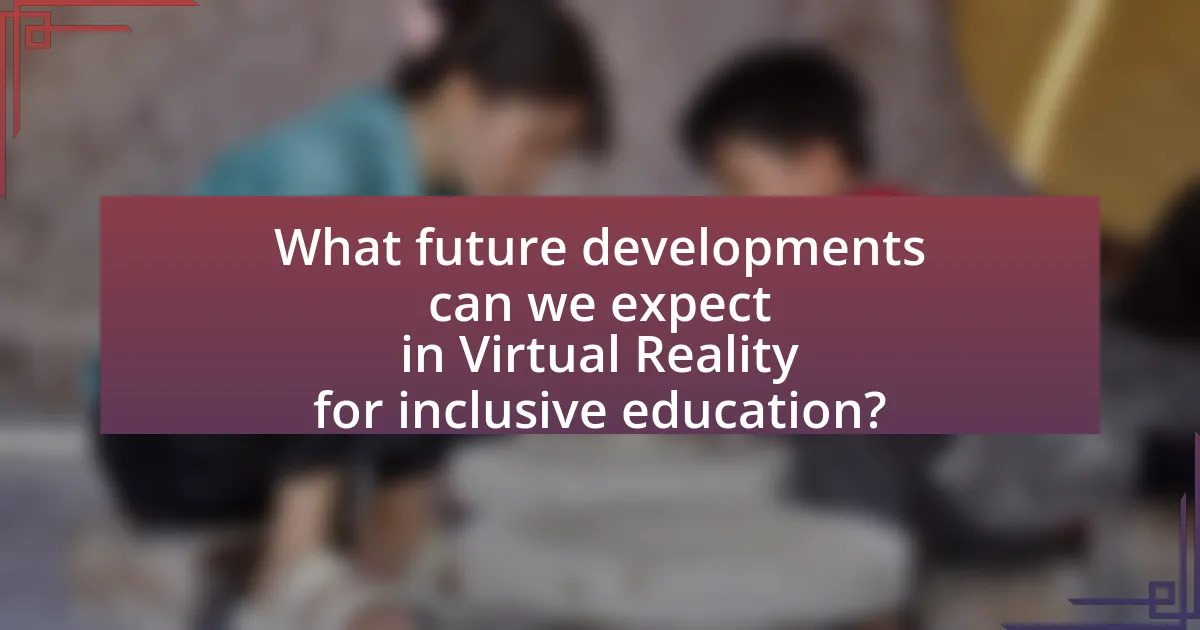
What future developments can we expect in Virtual Reality for inclusive education?
Future developments in Virtual Reality (VR) for inclusive education will focus on enhanced accessibility features, personalized learning experiences, and improved social interaction capabilities. These advancements aim to create immersive environments that cater to diverse learning needs, allowing students with disabilities to engage more effectively in educational settings. For instance, VR platforms are expected to integrate adaptive technologies that adjust content delivery based on individual learning styles and abilities, thereby promoting inclusivity. Additionally, research indicates that VR can facilitate social skills development through simulated interactions, which is crucial for students with social communication challenges. As VR technology continues to evolve, it will likely incorporate artificial intelligence to further tailor educational experiences, ensuring that all students, regardless of their disabilities, can benefit from immersive learning opportunities.
How is technology evolving to better serve students with disabilities?
Technology is evolving to better serve students with disabilities through advancements in assistive devices, software applications, and inclusive educational platforms. For instance, tools like speech-to-text software and screen readers enhance accessibility for students with visual or auditory impairments, allowing them to engage more fully in educational content. Additionally, virtual reality (VR) is being utilized to create immersive learning experiences tailored to individual needs, enabling students with disabilities to explore complex concepts in a safe and controlled environment. Research indicates that VR can improve engagement and retention of information among students with disabilities, as it provides interactive and experiential learning opportunities. This evolution in technology not only fosters inclusivity but also empowers students with disabilities to achieve their educational goals more effectively.
What innovations in VR technology could enhance learning experiences in the future?
Innovations in VR technology that could enhance learning experiences in the future include improved haptic feedback systems, adaptive learning environments, and AI-driven personalized content. Enhanced haptic feedback systems allow users to experience tactile sensations, making virtual interactions more immersive and engaging, which is crucial for students with disabilities who may benefit from multi-sensory learning. Adaptive learning environments can adjust in real-time to the needs of individual learners, providing tailored educational experiences that accommodate various learning styles and disabilities. AI-driven personalized content can analyze user interactions and preferences to deliver customized educational materials, ensuring that all students, including those with disabilities, receive the support they need to succeed. These innovations are supported by research indicating that immersive technologies can significantly improve engagement and retention in educational settings.
How can collaboration between tech developers and educators shape future VR tools?
Collaboration between tech developers and educators can significantly shape future VR tools by ensuring that these tools are designed with educational needs and accessibility in mind. Educators provide insights into pedagogical strategies and the specific requirements of students with disabilities, while tech developers apply this knowledge to create immersive and interactive VR experiences that cater to diverse learning styles. For instance, a study by the University of Southern California found that VR can enhance engagement and retention in students with disabilities when tailored to their unique learning needs. This partnership can lead to the development of VR tools that not only facilitate learning but also promote inclusivity, making education more accessible for all students.
What role can policy play in promoting the use of Virtual Reality in education?
Policy can play a crucial role in promoting the use of Virtual Reality (VR) in education by establishing funding mechanisms, setting standards for technology integration, and providing training for educators. For instance, government initiatives can allocate specific budgets for schools to acquire VR technology, ensuring equitable access for all students, including those with disabilities. Additionally, policies can mandate the inclusion of VR in educational curricula, thereby encouraging schools to adopt innovative teaching methods that cater to diverse learning needs. Research indicates that VR can enhance engagement and learning outcomes for students with disabilities, as evidenced by studies showing improved social skills and academic performance when VR is utilized in inclusive settings.
How can educational policies support the integration of VR for students with disabilities?
Educational policies can support the integration of VR for students with disabilities by providing funding for technology, establishing guidelines for accessibility, and promoting training for educators. Funding initiatives can ensure that schools have the necessary resources to acquire VR technology tailored for diverse learning needs. Guidelines for accessibility can mandate that VR content is designed to accommodate various disabilities, ensuring that all students can benefit from immersive learning experiences. Additionally, training programs for educators can equip them with the skills to effectively implement VR in their teaching practices, fostering an inclusive environment. Research indicates that schools with supportive policies see improved engagement and learning outcomes for students with disabilities when utilizing VR technology.
What funding opportunities exist for schools to adopt VR technology?
Schools can access various funding opportunities to adopt VR technology, including federal grants, state education funds, and private foundations. The U.S. Department of Education offers grants such as the Innovative Approaches to Literacy Program, which can be utilized for technology integration, including VR. Additionally, state-level initiatives often allocate funds specifically for technology in education, and organizations like the Chan Zuckerberg Initiative provide grants aimed at enhancing educational tools for diverse learning needs. These funding sources support the integration of VR technology, which can significantly enhance inclusive education for students with disabilities by providing immersive learning experiences tailored to individual needs.
What practical tips can educators follow when implementing Virtual Reality in their classrooms?
Educators can enhance the implementation of Virtual Reality (VR) in classrooms by ensuring accessibility, providing adequate training, and integrating VR into the curriculum. Accessibility is crucial; educators should select VR content that accommodates various disabilities, such as using platforms that offer audio descriptions and adjustable settings for visual impairments. Training is essential; educators must familiarize themselves with VR technology and its applications to effectively guide students. Integrating VR into the curriculum involves aligning VR experiences with learning objectives, which can enhance engagement and understanding, particularly for students with disabilities. Research indicates that immersive experiences can improve learning outcomes, as seen in studies where VR was used to teach complex subjects, resulting in higher retention rates among students with diverse learning needs.
